By Aaron Hover
Researchers at the University of Florida and a North Carolina institute have invented a chip-like device with a surface that turns from transparent to opaque so rapidly it can shield the eye or electronic sensors from potentially blinding lasers.
While the primary application of the "artificial eyelid" is military, consumer applications may range from programmable sunglasses to better cameras, said Paul Holloway, a UF professor of materials science and engineering and one of the researchers on the project.
"There are a whole host of applications," Holloway said.
Holloway and his colleagues at the UF College of Engineering and a non-profit North Carolina-based technology institute have successfully demonstrated prototypes of the device, which uses extremely tiny polymer and electrode films to control transmission of light. Part of the fast emerging field of nanotechnology — the creation of machines so small they can be viewed only with a powerful microscope, the eyelid is intended to protect military pilots and equipment from disabling laser attacks.
Holloway and other researchers in UF’s Department of Materials Science and Engineering contributed to the eyelid as part of research for the Defense Advanced Research Projects Agency, or DARPA, and the Army Research Office.
While largely seen as a future threat, contemporary reports of laser attacks are not unprecedented.
In an era when satellites are on the front lines of defense, lasers pose a big threat to national security, Holloway said.
"We rely a lot now in terms of our defense systems on overhead satellites," he said. "These satellites typically have high-power, high-resolution cameras. If somebody wants to avoid them, they can take a ground-based laser, point it up and knock out the cameras."
To counter the threat, Holloway and the other researchers used chip-making
techniques and materials to design and build a device that contains thousands
of tiny apertures that range in size from about a millimeter down to 50
micrometers (there are 25,400 micrometers in an inch). Tests of prototypes
showed the apertures can open and close as many as 10,000 times in one
second. When deployed, say, on a satellite camera, a tiny sensor would
detect the laser, shut down the apertures and protect the camera.


The artificial eyelid is composed of an array of microscopic
flaps that are normally curled down to allow normal vision but slam closed
to provide a reflective barrier to light. Within 1/10,000th of a second
after photocells mounted in front of the flaps detect a laser flash, positive
charges to the flaps and negative charges to a transparent electrode behind
it create an electrostatic attraction that causes the flaps to uncurl and
shut. The laser reflects off the closed flaps, which uncurl again
a fraction of a second later.
The device has several potential consumer applications, Holloway said.
For example, sunglasses now on the market that adjust to changing light
conditions use a photochromic process that may require several minutes
to complete the adjustment. Sunglasses with the eyelid technology, by contrast,
would adjust instantly by opening the appropriate number of apertures for
the light hitting the glasses, he said.
Cameras also could benefit. For example, the eyelid technology could be installed in home video cameras to eliminate the common problem in videotapes of a bright light darkening the content of the surrounding frame, Holloway said.
DARPA has provided about $500,000 for the research, part of more than $9 million the agency has committed for Holloway’s research at the Center for Materials in Sensors and Actuators, or MINSA. The other UF faculty members involved in the research are Tony Brennan, Elliot Douglass, Joseph Simmons and Wolfgang Sigmund. Besides the North Carolina institute, MCNC in Research Triangle Park, engineers from Clemson University, Pacific Northwest National Laboratory and Lockheed Martin in Orlando are involved.
Paul Holloway, pholl@mse.ufl.edu
Skulls May Be First Hominids Outside Of Africa
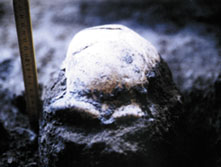
By Susan Antón
A University of Florida anthropologist is part of an international team whose discovery of early human skull remains in the Republic of Georgia represents the earliest known human ancestors from Eurasia and also may belong to the first hominid species to journey out of Africa. The team's findings appeared in May in the journal Science.
The team of researchers from Georgia, Germany, France and the United States found the nearly complete fossil cranium and another skullcap in Dmanisi.
The Science authors, who include UF’s Susan Antón, say the 1.7-million-year-old fossils are the first discovered outside of Africa to show clear signs of African ancestry. The age and skeletal characteristics of the Dmanisi skulls link them to the early human species Homo ergaster, a species that some researchers believe is the African version of Homo erectus.
"The age of the site confirms our work in Indonesia, which suggests that human ancestors left Africa fairly early — about 1.7 million or 1.8 million years ago, shortly after the evolution of relatively larger bodies and bigger brains but before significant advances in stone tool technology," Antón said.
Most scientists think Homo erectus was the first hominid species to leave the African continent, although the exact identity of these ancestral travelers and the timing of their departure have been hotly debated for decades. Under the classic scenario, Homo erectus, armed with an advanced tool kit called the Acheulean or hand-ax tradition, became the first human species capable of braving an array of challenging environments outside of Africa.
The Dmanisi fossils, however, may undermine this tale of the technologically triumphant hominid. Stone tools found with the two skulls are of the less sophisticated "pebble-chopper" type that preceded the Acheulean in Africa, and the site itself is older than any known Acheulean tools.
The fossils were retrieved during archaeological investigations of a medieval castle at Dmanisi. Meticulous geological investigation confirms that the human fossils, accompanying animal bones and tools, come from sediment-filled, irregularly shaped "burrows," scooped out of the ancient strata by the flow of groundwater, said co-author Reid Ferring of the University of North Texas.
More than 1,000 stone artifacts have been recovered from the Dmanisi fossil layers, providing further support to the 1.7-million-year-old date for the site. Despite the ready availability of raw material suitable for making Acheulean tools, the authors say, all of the Dmanisi artifacts are of a pre-Acheulean type that appeared in Africa as early as 2.4 million years ago.
If superior technology didn’t lead the way out of Africa, as the Dmanisi evidence suggests, what other factors may have prompted these early humans to leave the continent? The Science authors speculate that the move might have been appetite-driven.
"Basically the argument that we’re making is that during that time in Africa, the savanna is expanding and there is a greater availability of ‘protein on the hoof,’" Antón said. "With the appearance of Homo ergaster, we see bigger bodies that require more energy to run, and therefore need these higher-quality sources of protein as fuel."
She said as early humans shifted their diets to include larger amounts of animal protein, there probably was a corresponding expansion in their home range to match the ranges of these animals.
Researchers Craft Alternative Power Plant
By Aaron Hoover
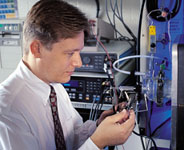
With prices at the gas pump going ever higher, a University of Florida researcher is improving on a new technology that could make cars three or four times more efficient without sacrificing comfort or power.
Eric Wachsman, an associate professor of materials science and engineering, recently received a $450,000 grant from the U.S. Department of Energy to build on promising research results involving fuel cells. The three-year project could hasten commercial application of a type of fuel cell known as the solid oxide fuel cell that would replace the internal combustion engine as the automobile’s power plant.
"There’s no question that the fuel cell is going to play a role in the automobiles of the future," he said. "The question is which type of fuel cell will be used."
Automakers and university researchers are pursuing the development of two main types of fuel cells: proton exchange membrane fuel cells and solid oxide cells, Wachsman said. Both rely on an electrochemical reaction to produce electricity, which then is used to provide power for the vehicle motor. Solid oxide cells have the potential to convert available fuels, such as gasoline, directly into electricity. Proton exchange membrane cells, by contrast, require another step: an on-board fuel-processing unit to convert the gasoline or other fuel into hydrogen, which then is converted into electricity.
Wachsman said the conversion process is complex and decreases the efficiency of the power system. It also adds significant cost, in part because it seeks only to produce hydrogen, rejecting other ingredients in the gasoline or other fuel, such as carbon. The alternative to the conversion process, however — powering cars with tanks of highly explosive hydrogen, is potentially dangerous and impractical.
"If you go to a hydrogen-based system, you’ve got to store hydrogen and that would require a whole new transportation infrastructure," he said. "The cost to convert every gas station in the United States to dispense a gaseous hydrogen instead of a liquid fuel would be a major impediment."
Besides not requiring hydrogen, solid oxide fuel cells are nonpolluting and highly efficient. But they also have a major downside: They require an operating temperature of more than 1,800 degrees Fahrenheit, far higher than the 220 degrees required by the proton exchange membrane fuel cell. For this reason, most research involving solid oxide fuel cells to date has focused on development of the cells for stationary power generation. "If you wanted to start the car with the current generation of solid oxide fuel cells, you would have to wait an hour or so for it to start up," Wachsman said.
Wachsman and colleagues in fuel cell research have demonstrated and patented an electrolyte, a major component of the solid oxide fuel cell, that can operate at less than 1,000 degrees. The goal of his current research is to reduce that temperature to about 500 degrees while improving the electrolyte’s performance and reliability. "If we can achieve this goal, the start-up time will be comparable with the proton exchange membrane fuel cell," he said.
Wachsman said he can’t say when the solid oxide fuel cell might appear in cars, in part because consumer application of the technology depends on the decisions of policy-makers, the automobile industry and the price of gasoline.
Whatever the date, the likely application for the fuel cell will be a fuel cell-battery combination known as a hybrid, he said. The fuel cell will constantly charge the battery, which will run the electric motor powering the car.
"Fuel cells give you a lot of energy density, or the ability to travel long distances, while batteries give you power density, or the ability to accelerate quickly," he said. "A hybrid allows you to have both at the same time."
Wachsman added the start-up time would be less of an issue with a hybrid car, because the car would start immediately on battery power while the fuel cell warms up.
Wachsman is not alone in pursuing the solid oxide cell for automobiles. BMW, Toyota and Nissan all have solid oxide fuel cell programs. "If gas prices in the United States were the same as in Europe and Japan, we would see fuel-cell-powered automobiles here very soon," he said.
Eric Wachsman, ewach@ufl.edu
Chemist Develops Tiny Genetic Tool Kit

By Aaron Hoover
University of Florida researchers are developing synthetic DNA molecules and nanoscale probes and particles to be used in the next generation of genetic research.
Before researchers can turn the wealth of data provided by the Human Genome Project into new medical treatments, they’ll need tiny tools to rearrange genes or gene parts and monitor the impacts. Now, University of Florida researchers are reporting success in developing a molecule that may serve as one such tool. Researchers have also created other tools that may identify disease or toxins in single cells before they invade the body.
The synthetic DNA molecule developed at UF will allow researchers to monitor the impacts of genetic therapy.
"This could be a way to ensure that you’re producing the proper amounts of a substance or chemical, or the amounts that you expected for whatever time period you wanted," said Sheldon Schuster, professor and director of UF's Biotechnology Program and one of the researchers.
Weihong Tan, an assistant professor of chemistry, recently collaborated with Schuster and two other UF researchers to construct what they describe as a "synthetic DNA beacon."
Published earlier this year in Angewandte Chemie International Edition, a prominent international chemistry journal, the research by Tan, Schuster, Jeffery Li and Xiaohong Fang produced a molecule that contains a "photophore," a substance that lights up only in the presence of a target protein, DNA or RNA molecule.
Researchers can use laboratory equipment to monitor when the light appears, allowing them to determine the absence or presence of the target protein or gene. The potential application is for such molecules to be used to detect the presence of proteins or genes in extremely low concentrations.
"What this DNA biosensor and other biosensors do is detect very small quantities of biological molecules with a high degree of specificity," Schuster said.
Tan also has crafted probes thousands of times thinner than human hair that physicians may one day insert into individual cells to test for disease. Additionally, he’s pioneering microscopic "nanoparticles" that could carry drugs directly to sickly cells to treat or exterminate them. All the tools meld biotechnology with the fast-emerging field of nanotechnology, which endeavors to create self-assembling molecular machines.
"In order to study cells and what goes on inside of them, you have to have tools or materials much smaller than the cells," Tan said.
Tan’s ultrasmall probe is similar to the DNA beacon, but its fluorescent dye-containing tip indicates biochemicals or substances in cells rather than genes. Measuring just 30 nanometers — a nanometer is one billionth of a meter, it does not harm or kill the cell and so can be used to monitor chemical changes in living cells.
Another major potential application of Tan’s research is earlier detection of antibodies.
"You’ll be able to detect antibodies much more efficiently and much easier, because you can detect them at much lower concentrations," he said.
The sensors also could be used as early indicators of chemical contamination pollution or chemical warfare, Schuster said.
"The military certainly has a need to know if either military or civilian populations are being bombarded with small concentrations of toxins," Schuster said. "The earlier you can detect them, the quicker you can respond."
Weihong Tan, tan@chem.ufl.edu
$15 Million Gift To Benefit Research At Brain Institute
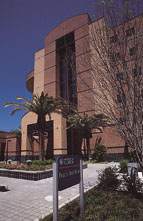
By Chris Brazda
The McKnight Brain Research Foundation has given the UF Brain Institute $15 million to support fundamental research into memory loss associated with aging.
The gift from the Miami-based foundation is the largest single cash gift ever to the university and is eligible for a 100-percent match from the State of Florida Trust Fund for Major Gifts, which would bring its total value to $30 million. In recognition of this donation, the Brain Institute and the 210,000-square-foot building that houses its principal operations will be named the Evelyn F. and William L. McKnight Brain Institute of the University of Florida.
"The McKnight gift for brain research in the area of memory loss signifies a quantum move in the national research arena," said Dr. Kenneth Berns, UF vice president for health affairs and dean of the College of Medicine. "We applaud the McKnight Brain Research Foundation for their investment and confidence in the University of Florida."
The establishment of the McKnight Brain Research Foundation provides a legacy of support for research toward the understanding of memory and the specific influences of the natural aging process. Evelyn McKnight established the foundation in 1999 to provide support for medical research of the brain, particularly memory loss of the aging.
McKnight, who was a nurse, and her husband, William, were very interested in effects of aging on memory. William McKnight was chairman of the board of the 3M Corp. for 59 years prior to his death in 1978. Evelyn McKnight continued to support his interest in memory loss research until her death in 1999.
The UF Brain Institute is the center of all brain and spinal cord research on the UF campus. About 300 UF researchers from 50 academic departments and 10 colleges, with collaborators at more than 75 universities and research institutes around the world, pool their talents to make important discoveries about the brain and transfer them to the patient.
"Brain and central nervous system disorders affect one in five Americans at any given time," said William G. Luttge, executive director of the UF Brain Institute. "Devastating losses in memory and other cognitive problems are seen with many of these conditions."
Luttge said the best way to achieve meaningful breakthroughs in the diagnosis and treatment of memory loss is through a major collaborative research program, coupled with state-of-the-art core research facilities, such as those at the UF Brain Institute.
"The McKnight gift will help catalyze a wide array of new initiatives ranging from the development of high-resolution brain functional imaging technologies to molecular and cellular studies of brain cell death and adaptation resulting from aging, sensory experience, disease and injury," Luttge said.
Two million dollars of the McKnight gift is allocated for a research professorship, which, with the state match, will result in a $4 million chair in the College of Medicine. The chair will be known as The Evelyn F. McKnight Chair for Brain Research in Memory Loss.
William G. Luttge, luttge@ufbi.ufl.edu
Two Professors Win Presidential Award
By Aaron Hoover
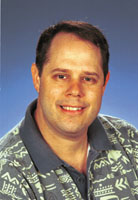
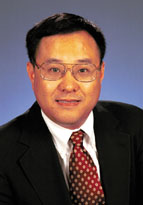
Two University of Florida researchers have won one of the nation’s
most prestigious awards for outstanding young scientists and engineers.
Richard Elston, an associate professor of astronomy, and Zhuomin Zhang,
an assistant professor of mechanical engineering, were recognized at a
White House ceremony with the Presidential Early Career Award for Scientists
and Engineers, or PECASE award. The White House describes the award as
"the highest honor bestowed by the U.S. government on outstanding scientists
and engineers who are in the early stages of establishing their independent
research careers."
Elston
Zhang
Five UF researchers have received the PECASE award since the program was launched in 1996. Last year’s recipient was Elston’s wife, Elizabeth Lada, also an associate professor of astronomy. Lada was a keynote speaker at a National Science Foundation event preceding the White House ceremony.
The award includes a five-year, $500,000 research grant for each faculty member.
Zhang’s research seeks to advance basic science involving heat transfer and thermodynamics and to apply the result to cutting-edge technological problems.
Elston’s research focuses on how galaxies and other structures emerged in the early universe. He said he will use his PECASE grant to continue his research in this area with an instrument he designed and helped build. The instrument is called the Florida Array Multi-object Imaging Near Infrared Grism Observational Spectrometer, or FLAMINGOS.
"In the past, we could observe only one object in a night," he said. "With FLAMINGOS, we’ll be able to observe in one night what used to require 100 nights.
Richard Elston, elston@astro.ufl.edu
Zhuomin Zhang, zzhang@cimar.me.ufl.edu
Researchers Find Bones Of Prehistoric Ground Sloth
By Cathy Keen

Bones excavated by University of Florida faculty and students over the past 14 years have been identified as those of a newly discovered ground sloth that is the oldest of its kind ever found in North America.
Weighing more than five tons and able to reach as high as 17 feet, the 2.2- million-year-old prehistoric creature was larger than today’s African bull elephants, said UF paleontologist David Webb.
"This is a great, wonderful animal unlike anything in existence whose huge size is almost reminiscent of the dinosaurs," Webb said.
Eremotherium eomigrans, as named in a recent academic journal article, was the earliest of the giant sloths known as megatheres to have migrated from South America north across the Panamanian Land Bridge, Webb said. Before the Ice Age, these slothful plant-eaters lumbered across the Florida peninsula like herds of elephants, using their fearsome claws to strip leaves from branches and entwine them in their long tongues, he said.
Unlike other large-bodied ground sloths, the new species had an extra claw, representing a surprisingly primitive stage of evolution, Webb said. While all other giant sloths had four fingers with only two or three claws, this one had five fingers, four of them with large claws, the biggest being nearly a foot long, he said.
"The existence of such sloths would have been expected at a much earlier time, and in South America, not Florida," he said.
This evolutionary pattern of a reduction in the number of fingers and claws over time continued into the present with its modern-day descendant, the much smaller three-toed sloth, which lives in the tropical forests of Central and South America, he said.
A university geology student found the ground sloth bones in 1986 during a class field trip at the Haile limestone quarry west of Gainesville. Over the years, a dozen other ground sloths were found, some completely articulated skeletons, and brought to UF’s Florida Museum of Natural History.
In 1989, Webb invited two of the world’s leading specialists on such animals to examine the bones. Castor Cartelle, a zoologist from the University of Belo Horizonte in Brazil, and Gerardo De Iuliis, a zoologist from the University of Toronto in Canada, studied the bones for a decade before concluding this was a new, huge find. The findings were published as a 20-page paper in the December issue of the Zoological Journal of the Linnean Society of London.
The fossil deposit was unusual in that it was found in what was a quiet pond, which allowed for excellent preservation, Webb said. Most fossil collections in Florida are found in small sinkholes or in stream deposits, where the bones are stirred up, he said.
"Because bones are usually scattered, you would probably never know for sure how many claws an animal had, as we were able to determine with this ground sloth," he said.
The bones of one of the largest, most-complete individuals will be assembled at the Natural History Exhibit Hall in Livingston, Mont. Matt Smith, a professional fossil preparator, said visitors to nearby Yellowstone National Park can stop and see him work through a picture window. The skeleton is to be posed in an upright position, as if stripping branches from a tree, and the finished product will be returned to UF in 18 months for display.
David Webb, webb566@ufl.edu
Stability Of Prehistoric Antarctic Ice Debated
By Aaron Hover 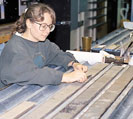
A research team led by University of Florida geologists is the first to find evidence that parts of the Antarctic ice sheet have undergone episodes of massive instability that appear to correspond with periods of unusually warm temperatures in the Northern Hemisphere during the last ice age.
The findings, which appeared in the journal Science in June, add to a growing body of evidence suggesting polar ice can undergo huge and rapid changes that may be tied to climate, said Sharon Kanfoush, a UF graduate student and lead researcher on the project.
"The fact that the ice sheet has behaved very dynamically in the past,
or undergone very rapid changes in the past, implies that 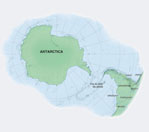 such
changes are possible in the future," Kanfoush said.
such
changes are possible in the future," Kanfoush said.
Geologists have known for several years that the Northern Hemisphere ice sheet has shed huge chunks of ice in the form of icebergs at intervals of 1,000 years or more during the last period of glacial advancement, which extended from about 60,000 to 20,000 years ago. Researchers believe the ice sheet "calved" virtual armadas of icebergs just before extreme climatic periods that, over Greenland, resulted in as much as a 60-degree atmospheric temperature increase in 50 years. The Northern Hemisphere ice sheet instability and subsequent warming spikes have spurred considerable discussion and debate.
Until the UF work, however, no one had sought to broaden the issue by probing what happened to the Antarctic ice sheet in the same glacial period, said David Hodell, professor of geological sciences and the other UF researcher on the project.
The team discovered that parts of the Antarctic ice sheet also were unstable during the warming spikes in the Northern Hemisphere.
Two factors may be at work, Hodell said. One, the higher temperatures may have caused the Northern Hemisphere glaciers to melt, raising sea levels and causing grounded ice in the seas near Antarctica to become unstable. Alternatively, the higher temperatures may have altered the circulation of global ocean currents, bringing more warm water to Antarctica and causing its ice shelf to begin to break up.
Four massive icebergs broke off from the Ross Ice Shelf in Antarctica last spring, the latest of several iceberg events that have focused attention on global warming and its possible impact on Antarctica. Hodell said the UF team’s research has no direct bearing on the recent events because the climate during the glacial-advancement period was fundamentally different from the climate in the modern era of glacial retreat.
But Hodell added that if water temperature increases or rising sea levels caused the Antarctic ice instability in the past, similar increases could do the same today.
"You could make the analogy that finding these events during the last glacial period suggests that these grounded ice shelves are inherently unstable and susceptible to either temperature or sea- level change," he said.
The team came to its conclusions based on analysis of sediment cores from a series of sites in the southern Atlantic obtained on two separate research cruises, including one cruise on the JOIDES Resolution, a scientific research ship operated by the International Ocean Drilling Program. The cores, samples of material from as far as 4,600 meters beneath the sea floor, contained large grains of quartz derived from Antarctica as well as fragments of volcanic material.
The researchers concluded the minerals were deposited by melting icebergs that had split off from Antarctica near the Weddell Sea, then drifted north and east in the south Atlantic before melting.
Other members of the research team came from the Scripps Institute of Oceanography at the University of California at San Diego; the Lawrence Livermore National Laboratory in Livermore, Calif.; and the Lamont-Doherty Earth Observatory of Columbia University.
Sharon Kanfoush, skanfou@ufl.edu
David Hodell, hodell@nersp.nerdc.ufl.edu
For 21st-Century Campers, A Tent That Sets Itself Up
By Aaron Hoover

Think of it as the Jetsons meet the Boy Scouts.
Two University of Florida professors have designed the structure for a tent that has no easy-to-forget poles, no instructions and no need for setup. Once removed from its bag, the tent would "self-deploy" in seconds.
"It will be especially convenient during the rain or cold weather," said Joseph Duffy, a UF mechanical engineering professor who has applied for a patent on the tent structure and other so-called "self-deployable tensegrity structures" with colleague Carl Crane, also a UF mechanical engineering professor.
A contraction of tension and integrity, tensegrity refers to rigid structures that rely on a continuous network of tension. The Georgia Dome in Atlanta is among several large tensegrity stadiums or other structures around the country.
Duffy, director of the UF Center for Intelligent Machines and Robotics, was toying with model tensegrity structures last year when he realized that by replacing some of the pieces with elastic bands, he could make them collapse onto themselves when compressed, then rebound to full size when released.
He and Crane built several shoebox-sized models of the tent and other shapes. Once the patent is granted, they say, their first product on the market likely will be a sun tent for the beach.
Other products, possibly including children’s toys, will follow, but the researchers aren’t focusing entirely on the consumer market. Their research recently caught the attention of the Air Force Research Laboratory at Tyndall Air Force Base near Panama City, which has provided $50,000 to explore making larger tents for equipment and as temporary airplane hangars.
Duffy said teams of a half-dozen trained soldiers currently require the better part of a day to set up some of the Air Force’s largest tents. "I think they’d like to reduce the number of people and the time required, and these tensegrity structures offer that potential," he said.
The research also has drawn attention for its potential in a very different area: satellite antennas. Satellites need to be as compact and light as possible when lofted into space, but antennas are by their nature bulky and heavy. Tensegrity structures, however, can be used to self-deploy antennas from a stowed position, Duffy said.
He demonstrated the concept using a tiny six-sided model made of wooden dowels and elastic bands. Fully deployed, the model looks like the structure for two diametrically opposed satellite dishes, perhaps useful as receiving and sending antennas, he said. Compressed in his hand, it reduces to a fraction of its deployed size.
A joint proposal with the Harris Corp., a leading antenna manufacturer, outlining the idea won a prestigious Director’s Innovative Initiation Award — and $450,000 for a one-year period — from the National Reconnaissance Office, a government agency that builds and operates the nation’s reconnaissance satellites. Also contributing to the research is the Air Force Office of Scientific Research, which is providing $120,000 to Duffy and Crane to develop self-deployable tensegrity theory.
Joseph Duffy, duffy@cimar.me.ufl.edu
Carl Crane, carl@cimar.me.ufl.edu